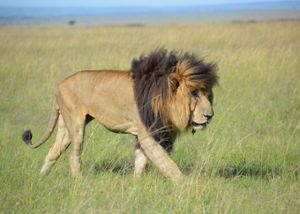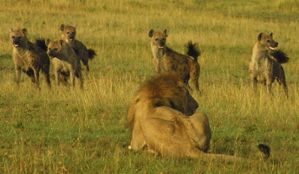The wild, widespread consequences of hosting a single-celled parasite
When humans began transporting domestic animals around the globe, a microscopic organism seized the opportunity to start its own wildly successful journey. . . hitchhiking inside their brains.
Today, more than 40 million people in the United States and up to a third of the global population are estimated to be infected with Toxoplasma gondii, a single-celled parasite with a singular goal: to infect any warm-blooded animal until it is ingested by a wild or domestic cat. Within these feline species, the parasite can sexually reproduce to create millions more versions of itself.

“T. gondii has been called the world’s most generalist parasite and is an astonishingly interesting and understudied organism,” said Eben Gering, assistant professor at NOVA Southeastern University in South Florida and former Michigan State University postdoc in the lab of integrative biology professor Tom Getty. “After infecting a feline host, T. gondii shifts from asexual to sexual reproduction to produce millions of diploid spores that are shed via feces and remain infectious in soil or water for months. It’s an evolutionary jackpot from the parasite’s perspective.”
Gering and Zachary Laubach, a postdoc at the University of Colorado-Boulder and former member of University Distinguished Professor Kay Holekamp’s lab, conducted a first-of-its-kind study into the role of T. gondii in the wild, establishing its definitive presence and influence among free-living hyenas.
The ground-breaking paper resulting from this partnership was recently published in Nature Communications and covered by National Geographic.
“The unique interplay of Eben’s creative insight, the amazing empirical work of Zach Laubach and many people in Kay Holekamp’s group, along with support from the BEACON Center for the Study of Evolution in Action, sparked and supported an effort that is an exemplary illustration of the power of collaboration,” said Getty, who is also chair of the Department of Integrative Biology in the College of Natural Science. “I am thrilled to have had the opportunity to participate in this collaborative effort.”

Luck has nothing to do with T. gondii’s ability to host hop its way into felines. Experimental studies have shown the parasite manipulates a suite of traits in intermediate hosts that encourage feline predation. For example, infected mice exhibit decreased aversion to cat urine and loss of motor coordination, and even infected humans demonstrate riskier behavior than uninfected peers.
Gering and Laubach were fascinated by the idea that these effects might have evolved to help the parasite exploit its hosts, promoting its own transmission. They also noted that prior studies had chiefly ignored T. gondii’s effects on the behavior of wild hosts, where the parasite’s manipulative abilities presumably evolved.
Encouraged by the BEACON Center to think collaboratively and outside the box, Gering and Laubach managed to assemble a team with the diverse skills and resources needed to tackle the complex research questions from both host and parasite perspectives. It included the unprecedented, decades’ long field dataset from Kenya’s Masai Mara National Reserve, or the Mara.
Scientists from Holekamp’s research group have been systematically documenting and archiving hyena behaviors on the Mara every day since 1988. Detecting any links between T. gondii infection and hyena behavior seemed worth exploring given the Holekamp group’s prior discoveries about the importance of feline interactions for hyena survival and reproduction.
Because the parasite can affect human fetal development, it has important consequences for humans who live in the Masai Mara, so the team’s first aim was to examine whether feral animals or livestock were impacting the parasite’s abundance in this ecosystem.
Combining Laubach’s expertise on hyena life history, his formidable statistical toolkit and Gering’s expertise in malarial parasites was key to finding ways to test for the history of infection among hyenas and to interpreting veterinary diagnostics. Using the novel ELISA-based assay on hyena plasma samples, the team found that an astounding 65 percent of hyenas had antibodies for T. gondii.

“The high prevalence of infection, particularly among older hyenas, suggests that over the course of development there is substantial risk of infection, which is similar to recent work on T. gondii infection among carnivores living in Tanzania,” explained Laubach.
Proximity to livestock and feral animals, it turns out, was not a factor in infection rates, but age was. Adults were more likely to be infected than hyena cubs, but when hyena cubs did get infected, it often cost them their lives. Infected cubs got closer to lions than uninfected cubs and had higher rates of lion-inflicted mortality.
After 731 separate observations of hyena lion interactions and almost 4,000 distance estimates, the researchers had the first definitive link ever observed between T. gondii infection, boldness toward felids under natural conditions and fitness in a wild host population.
“I can’t think of many other systems in which such detailed demographic information—including hyena age, sex, clan membership and dominance status—can be examined alongside the parasite’s relationship to un-staged interactions between wild hosts and felines,” Gering said. “Collaboration with the Holekamp lab has given me a much deeper appreciation for how powerful the hyena system is for asking a whole host of biological questions. It was a pleasure working with co-lead author, Zachary Laubach to tackle questions surrounding effects of parasitism on these animals.”
Laubach and Gering are currently conducting follow-up studies to better understand the significance of T. gondii for spotted hyenas and other wild and feral animals.
“Human activities have a big effect on the distribution and evolution of this parasite, so if we want to understand how we are affecting contemporary ecosystems and wild populations, we need to give more consideration to the parasite’s role,” Gering said. “That means going beyond simple experiments that link infection to the hormones or behavior of a single host and examining the broader consequences of parasite infection for animal behavior and survival in complex, real world ecosystems.”
Banner image: At the Maasai Masa National Reserve in Kenya, shown here, lions and hyenas compete for food and territory. MSU scientists have conducted a groundbreaking study into the role of the parasite T. gondii in these interactions, establishing its definitive presence and influence among free-living hyenas. Credit: Lily Johnson-Ulrich